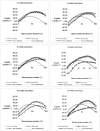Effects of collagen membranes enriched with in vitro-differentiated N1E-115 cells on rat sciatic nerve regeneration after end-to-end repair
- PMID: 20149260
- PMCID: PMC2829579
- DOI: 10.1186/1743-0003-7-7
Effects of collagen membranes enriched with in vitro-differentiated N1E-115 cells on rat sciatic nerve regeneration after end-to-end repair
Abstract
Peripheral nerves possess the capacity of self-regeneration after traumatic injury but the extent of regeneration is often poor and may benefit from exogenous factors that enhance growth. The use of cellular systems is a rational approach for delivering neurotrophic factors at the nerve lesion site, and in the present study we investigated the effects of enwrapping the site of end-to-end rat sciatic nerve repair with an equine type III collagen membrane enriched or not with N1E-115 pre-differentiated neural cells. After neurotmesis, the sciatic nerve was repaired by end-to-end suture (End-to-End group), end-to-end suture enwrapped with an equine collagen type III membrane (End-to-EndMemb group); and end-to-end suture enwrapped with an equine collagen type III membrane previously covered with neural cells pre-differentiated in vitro from N1E-115 cells (End-to-EndMembCell group). Along the postoperative, motor and sensory functional recovery was evaluated using extensor postural thrust (EPT), withdrawal reflex latency (WRL) and ankle kinematics. After 20 weeks animals were sacrificed and the repaired sciatic nerves were processed for histological and stereological analysis. Results showed that enwrapment of the rapair site with a collagen membrane, with or without neural cell enrichment, did not lead to any significant improvement in most of functional and stereological predictors of nerve regeneration that we have assessed, with the exception of EPT which recovered significantly better after neural cell enriched membrane employment. It can thus be concluded that this particular type of nerve tissue engineering approach has very limited effects on nerve regeneration after sciatic end-to-end nerve reconstruction in the rat.
Figures





Similar articles
-
Neural cell transplantation effects on sciatic nerve regeneration after a standardized crush injury in the rat.Microsurgery. 2008;28(6):458-70. doi: 10.1002/micr.20524. Microsurgery. 2008. PMID: 18623156
-
Use of hybrid chitosan membranes and N1E-115 cells for promoting nerve regeneration in an axonotmesis rat model.Biomaterials. 2008 Nov;29(33):4409-19. doi: 10.1016/j.biomaterials.2008.07.043. Epub 2008 Aug 23. Biomaterials. 2008. PMID: 18723219
-
Use of chitosan scaffolds for repairing rat sciatic nerve defects.Ital J Anat Embryol. 2010;115(3):190-210. Ital J Anat Embryol. 2010. PMID: 21287974
-
Use of PLGA 90:10 scaffolds enriched with in vitro-differentiated neural cells for repairing rat sciatic nerve defects.Tissue Eng Part A. 2008 Jun;14(6):979-93. doi: 10.1089/ten.tea.2007.0273. Tissue Eng Part A. 2008. PMID: 18447635
-
Methods for the experimental functional assessment of rat sciatic nerve regeneration.Neurol Res. 2004 Mar;26(2):186-94. doi: 10.1179/016164104225013833. Neurol Res. 2004. PMID: 15072638 Review.
Cited by
-
Effects of umbilical cord tissue mesenchymal stem cells (UCX®) on rat sciatic nerve regeneration after neurotmesis injuries.J Stem Cells Regen Med. 2014 Apr 30;10(1):14-26. doi: 10.46582/jsrm.1001004. eCollection 2014. J Stem Cells Regen Med. 2014. PMID: 25075157 Free PMC article.
-
An Overview of the Use of Equine Collagen as Emerging Material for Biomedical Applications.J Funct Biomater. 2020 Nov 1;11(4):79. doi: 10.3390/jfb11040079. J Funct Biomater. 2020. PMID: 33139660 Free PMC article. Review.
-
Fiber-reinforced scaffolds in soft tissue engineering.Regen Biomater. 2017 Aug;4(4):257-268. doi: 10.1093/rb/rbx021. Epub 2017 Aug 4. Regen Biomater. 2017. PMID: 28798872 Free PMC article. Review.
-
Development of Controllable Perfusion Culture Scaffolds Using Multi-Channel Collagen Gels: Effects of Gelation Conditions on Channel Formation and Media Supply.Polymers (Basel). 2025 Jan 23;17(3):287. doi: 10.3390/polym17030287. Polymers (Basel). 2025. PMID: 39940490 Free PMC article.
-
Evaluation of biodegradable electric conductive tube-guides and mesenchymal stem cells.World J Stem Cells. 2015 Jul 26;7(6):956-75. doi: 10.4252/wjsc.v7.i6.956. World J Stem Cells. 2015. PMID: 26240682 Free PMC article.
References
-
- Lundborg G. In: Severe Traumatic Defects of the Upper Limb. Masquelet AC, Ferreira AC, editor. London: Martin Dunitz; 2003. Bridging nerve defects: the role of tissue interpositioning; pp. 153–167.
-
- Siemionow M, Brzezicki G. Current techniques and concepts in peripheral nerve repair. Int Rev Neurobiol. 2009;87:139–170. - PubMed
-
- Gordon T, Sulaiman OA, Ladak A. Electrical Stimulation for Improving Nerve Regeneration: Where do we stand? Int Rev Neurobiol. 2009;87:433–444. full_text. - PubMed
-
- Doolabh VB, Hertl MC, Mackinnon SE. The Role of Conduits in Nerve Repair, a Review. Rev Neurosci. 1996;7:47–84. - PubMed
Publication types
MeSH terms
Substances
LinkOut - more resources
Full Text Sources
Other Literature Sources

